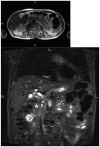Acute Cholecystitis from Biliary Lithiasis: Diagnosis, Management and Treatment
- PMID: 36978349
- PMCID: PMC10044554
- DOI: 10.3390/antibiotics12030482
Acute Cholecystitis from Biliary Lithiasis: Diagnosis, Management and Treatment
Abstract
Biliary lithiasis is a global disorder affecting nearly 20% of the world's population, although most cases occur without symptoms. Gallbladder stones could move into the common bile duct after gallbladder contraction, causing acute cholecystitis. The progression of the acute disease can take different forms, from mild inflammation, treatable with oral antibiotics, to the most severe forms with septic shock or biliary peritonitis, requiring specific treatment. Liver function tests and abdominal ultrasound are generally sufficient for diagnostic purposes. The most commonly used antibiotic is penicillin, with piperacillin achieving the best results; alternatively, fluoroquinolones could also be used, although there is no univocal consensus and surgery remains the only definitive treatment. A prolonged antibiotic therapy after cholecystectomy seems inadvisable, except in severe cases and/or in the immuno-compromised patient, where it should be periodically evaluated to avoid antibiotic resistance and unnecessary use. This review presents an evidence-based analysis to describe the advantages and disadvantages of the available options for the treatment of biliary lithiasis and cholecystitis, from the pathophysiological mechanisms behind lithiasis formation and also covering the main diagnostic findings for biliary stones, recommending an approach tailored to the patient's characteristics and to the team's expertise.
Keywords: acute cholecystitis; antibiotics; biliary lithiasis; cholecystectomy.
Conflict of interest statement
The authors declare no conflict of interest.
Figures




References
-
- Wang L., Mirzaie S., Dunnsiri T., Chen F., Wilhalme H., MacQueen I.T., Cryer H., Eastoak-Siletz A., Guan M., Cuff C., et al. Systematic review and meta-analysis of the 2010 ASGE non-invasive predictors of choledocholithiasis and comparison to the 2019 ASGE predictors. Clin. J. Gastroenterol. 2022;15:286–300. doi: 10.1007/s12328-021-01575-4. - DOI - PMC - PubMed
-
- Peery A.F., Crockett S.D., Murphy C.C., Lund J.L., Dellon E.S., Williams J.L., Jensen E.T., Shaheen N.J., Barritt A.S., Lieber S.R., et al. Burden and Cost of Gastrointestinal, Liver, and Pancreatic Diseases in the United States: Update 2018. Gastroenterology. 2019;156:254–272.e11. doi: 10.1053/j.gastro.2018.08.063. - DOI - PMC - PubMed
Publication types
LinkOut - more resources
Full Text Sources

